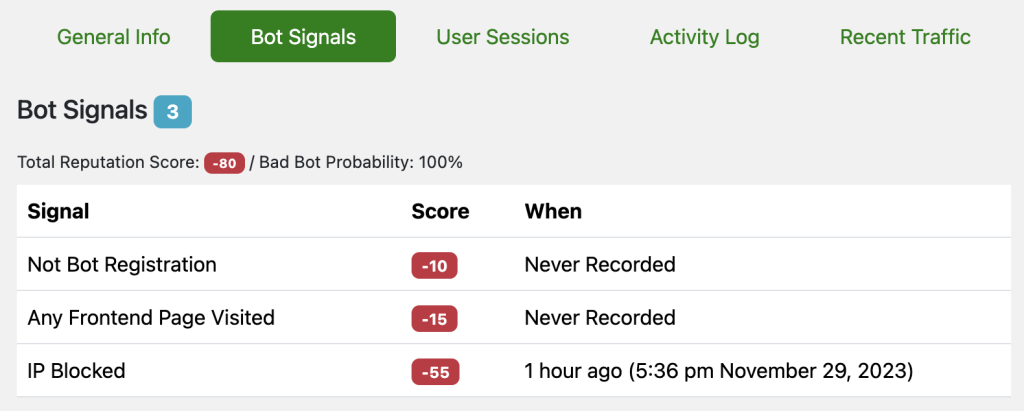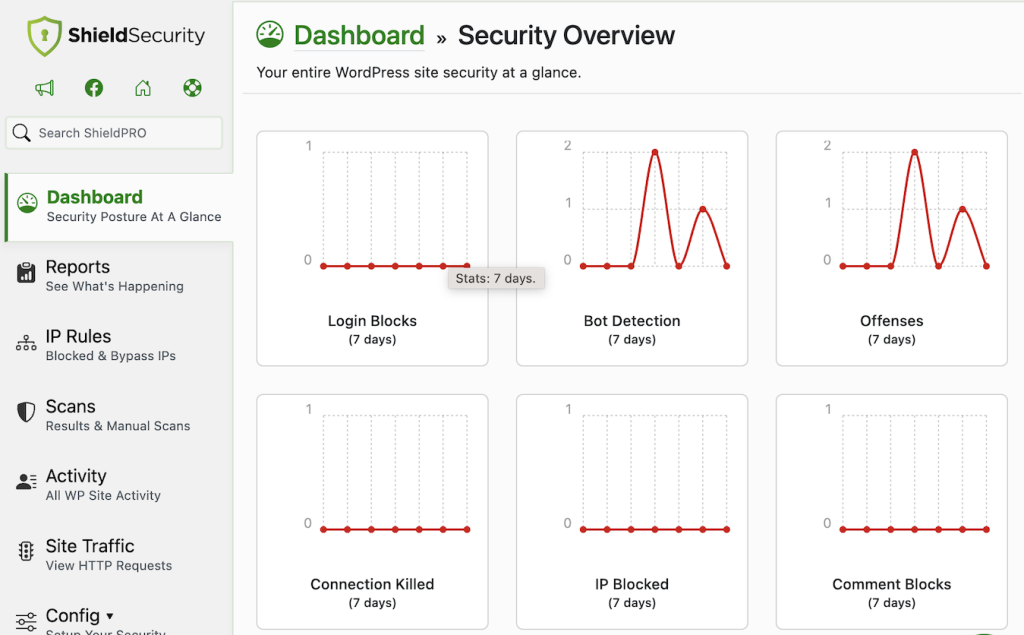When you picture your website visitors, you most likely picture a person sitting at a desk, or perhaps scrolling on their phone. However, not all your site’s visitors are flesh and bone; many are in fact bots, running automated tasks.
Although some of these bots are legitimate, others can put your site at risk, so it’s important to take appropriate security measures. This article will take you through the ways bots interact with your site, give you some insights on the risks of leaving bad bots unchecked, and take you through how Shield Security PRO can help protect your site.
What are WordPress bots?
Before we dive into how to protect your WordPress site from bad bots, let’s take a step back and talk about bots in general. Put simply, a bot is software that runs an automated task.
Many of the bots that visit your website are perfectly fine – and, indeed, there are many good bots that you want to visit your site. For example, search engine crawlers automatically evaluate the value of your site’s content to determine its rank in search results.
However, there are also bots out there designed with nefarious purposes in mind. In the next section, we will look at good vs. bad bots in more detail so you know which ones you need to look out for.
It’s worth remembering: One of the key challenges in cybersecurity is giving both good bots and human users a positive experience on your site, without enabling malicious bots to wreak havoc and compromise your security.
Good bots vs. bad bots
You may be surprised to learn that there are several kinds of good bots out there that should be perfectly welcome on your website. We mentioned search engine crawlers earlier, but they’re just one form of friendly bot that could visit your site. Others include:
- Uptime monitoring bots: These collect performance data so you can see how well your site is doing
- SEO tracking bots: Many sites looking to improve their search engine ranks use analytics software to evaluate results. Tracking bots collect the data reflected in your key performance indicators.
- Translation bots: These assist with language translation by automatically translating content to another language, helping viewers understand what your web pages are about.
- AI Bots: AI companies use site crawlers to train their AI systems, particularly in terms of language learning.
Some types of bad bots include:
- Comment spam bots: These are bots that automatically leave irrelevant comments on your site, often advertising another product or service, and generating links to that site.
- Brute force bots: Some cybercriminals use bots to perform brute force attacks in order to guess login credentials and gain access to restricted information.
- Probing bots: These are bots that simply probe your site for vulnerabilities – you can think of them as casing the joint. If they find any, they make a note so attackers can come back and exploit those vulnerabilities later.
All of these can sap your resources and make you more vulnerable to major cyber security threats. The right cyber security approach will allow good bots to do their thing without leaving the door open to the baddies.

Real-world Examples: How bad bots put your website at risk
Left unchecked, bad bots can damage your business in both the short and long term. They can drain your resources and increase your vulnerability to hacking attempts. Bots may flood your contact forms and comment sections with spam, which clutters your site and damages your credibility.
One example of enabling bots to run wild on your site is the Dunkin Donuts attack in 2015. The Dunkin Donuts brute force attack happened when hackers began using a type of attack called “credential stuffing” to gain access to and steal money from customer accounts. This is when bots use compromised passwords obtained from previous breaches to log in to their accounts and steal their data and card details.

According to a lawsuit filed against Dunkin, the coffee shop’s parent company failed to address the attacks, despite warnings from developers to do so. While they never denied or accepted responsibility for the hacks, the company agreed to a $650,000 settlement.
This illustrates that the stakes can get very high, especially when you’re handling sensitive information. Blocking bad bots from your website protects your business, your customers and your reputation, by restricting access to your site and data.
Bots are a drain on your site’s resources
Even if bots don’t put you in direct financial harm, they will still consume your site’s resources.
An example of this is the case of Geeks2you, where bots were used to attempt to gain access to their servers. Monitoring software discovered over 8,000+ failed login attempts, and at least another 5,000 each hour after the attack was discovered.
While it was extremely hard for them to actually get into the server (thanks to the company’s excellent password policy), with at least two attempts to hack every second, the attack ate into resources and rapidly degraded the site’s responsiveness to legitimate visitors.
This demonstrates the harmful impact bots can have, even just for failed attempts to hack a site. Users can be robbed of a pleasant experience, sites can load slowly, images may not look right, and on-page features may fail. This can damage your reputation and cause you to lose valuable traffic.
Bottom line: At a minimum, bad bots hog your resources and drag down your site’s performance.

Your Solution: The AntiBot Detection Engine
When it comes to stopping bot traffic, you need to find a technological solution that can filter out the bad and leave you with the good. This is where Shield Security PRO comes in.
The AntiBot Detection Engine, or ADE, works to distinguish between good bots, bad bots, and human users based on the behaviour of each visitor on the site. It can also distinguish fake web crawlers from true web crawlers.
The way the technology does this is with “bot signals” it watches for when visitors interact with the site. (We’ll take a closer look at how the ADE does this in the next section.)

When a user crosses the threshold of acceptable suspicious activity, Shield Security PRO automatically blocks their IP address and stops them from being able to access your site.
Spotting bot behaviour: login attempts
One example of bad bot behaviour the ADE is designed to spot is excessive login attempts. Shield Security PRO can detect and capture login bots that can slow down your site and cause harm going forward. It does this by penalising visitors who use a valid username but the wrong password, as well as trying to log in without a username or with a username that doesn’t exist.
Legitimate users might get their username and password wrong once in a while, but their behaviour is still going to be easy to distinguish from bots, especially when you look at their actions across the site as a whole.
“Bots are just computer programs,” said Paul Goodchild, creator of Shield Security PRO, “They perform a limited number of tasks, such as login attempts, comment SPAM, and probing to trigger 404 errors.
“When you look at all these actions collectively,” Goodchild continued, “it looks nothing like normal human activity. The ADE acts as a ‘bot watcher’, looking at all requests collectively to sort the bots from the people.”
All-sides defence with Shield Security PRO
ADE and bad bot blocking are core features of Shield Security PRO, but they’re also just a couple of the plugin’s features designed to keep your site safe and secure. For example, the security plugin has a comprehensive dashboard that allows you to see the current state of your website at a glance.

Other functionalities that help Shield Security PRO protect your site include:
- DoS protection with traffic rate limiting: This essentially limits the rate at which traffic can access a network or web service, stopping it from being overwhelmed. DoS attacks aim to overwhelm a system’s resources, ultimately slowing or shutting down the site.
- Malware detection and vulnerability scanning: These are essential to your website’s safety, and identify and mitigate potential threats to your system. Our technology offers real-time protection and firewalls, scans for patterns or signs of existing malware, and identifies flaws and weak points in your defence.
- Login protection for WooCommerce and other WordPress plugins: Shield Security PRO allows you to set up strong password requirements and two-factor authentication, keeping site access secure. You can also set customizable login attempt limits to further protect your site from malicious access attempts.
Cybersecurity is most effective when you tackle it from all sides. The Shield Security PRO plugin kicks bad bots and suspicious visitors off your site and helps you detect any threats that do manage to sneak through.
Banish bots from your site with Shield Security PRO
If you let bad bots have unlimited access to your site, you’re taking a serious risk. Bad bots can increase your chances of hacking and data loss, as well as hog server resources and slow your site down. Both of these can damage your reputation as well as your bottom line.
Site owners can take action and protect their websites with a bad-bot blocking plugin like Shield Security PRO. The ADE efficiently identifies bad bots and blocks their IP addresses so they can’t bring their nefarious plans to fruition.
Don’t delay, get started with Shield Security PRO and kick bad bots off your site today for instant peace of mind.
Hello dear reader!
If you want to level-up your WordPress security with ShieldPRO, click to get started today. (risk-free, with our no-quibble 14-day satisfaction promise!)
You'll get all PRO features, including AI Malware Scanning, WP Config File Protection, Plugin and Theme File Guard, import/export, exclusive customer support, and much, much more.
We'd be honoured to have you as a member, and look forward to serving you during your journey towards powerful, WordPress security.



